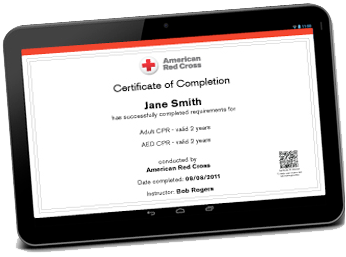-
What is AED?
If you're wondering what an AED is – and why they seem to be located in most offices and public buildings, you're not alone. In fact, because these devices are now commonly available, more people than ever before are curious about them. So – just what is an AED?
What Does AED Stand for?
AED stands for automated external defibrillator.
What is an AED Used for?
AEDs are used to help those experiencing sudden cardiac arrest. It's a sophisticated, yet easy-to-use, medical device that can analyze the heart's rhythm and, if necessary, deliver an electrical shock, or defibrillation, to help the heart re-establish an effective rhythm.
The device is designed to be user-friendly, with clear instructions on how to use it in case of an emergency. It's important for everyone to be aware of what an AED is and how to use it, as it could make a difference in saving someone's life.
AED - Step by Step
Courses through the Red Cross will train you on the proper AED steps, so you can ensure you’re using an AED the right way. To refresh your skills after becoming AED certified, you can come back and review this 7 steps of using an AED guide.
Why Learn to Use an AED
Sudden cardiac arrest is among the leading causes of death in the United States. In fact, more than 350,000 people will suffer a cardiac arrest this year. Currently, the only way to restore a regular heart rhythm during cardiac arrest is to use an AED.
Of course, you can – and should – request the assistance of trained medical professionals. However, because the average response time for first responders once 911 is called is 8-12 minutes, and for each minute defibrillation is delayed, the odds of survival are reduced by approximately 10%, having access to and AED and knowing how to use one, is critical.
CPR/AED Classes
At the Red Cross, you can choose the type of class for your schedule – and the way you learn best. For those who want to become certified in CPR/AED, you can choose from three types of courses, including:
- In Person: Designed for those who learn best in a traditional classroom setting, our in-person courses combine lecture with hands-on skills sessions. This way, you can not only learn what an AED is, what it looks like, how to it, but you can demonstrate your skills to a certified instructor. If the course is completed with a passing grade, you'll receive a two-year certification.
- Online: Perfect for those who want the freedom to take self-paced courses, our online classes can help you learn AED best practices. However, online safety training courses do not allow you to demonstrate your skill proficiency to a certified instructor, and therefore your certification may not meet the requirements for workplace safety.
- Blended Learning: Featuring award-winning simulation learning, our blended learning programs combine self-paced, interactive instruction and in-person skills sessions. That way, you can learn what an AED is – and how to use one – in theory and in practice. Additionally, because this option allows you to demonstrate your skills to a certified instructor, you can receive full certification with a passing score.
AED Course Topics
Typical topics covered in Red Cross AED classes include:
- Recognizing Emergencies and Gaining Confidence to Act
- Emergency Action Steps
- Recognizing Cardiac Arrest
- Giving CPR
- Safe and Effective Use of AEDs
We have courses geared towards CPR and AED use for infants, children, and adults. In our Adult Child and Baby First Aid/CPR/AED course, additional topics may include:
- AED use for adults and children
- Signs of pediatric cardiac arrest
- How to use AEDs in children and infants safely
Why Train With the Red Cross
Red Cross CPR/AED Training Saves Lives
Reid Heiser, Life Saver
One week after 17-year-old Reid completed his Red Cross CPR training, he needed to use it. In November 2011, Reid saved the life of Jim Hammer after he collapsed at the recreation center where Reid worked. Now friends, they share their story.Red Cross training matters
For more than a century, we've prepared people to respond to emergencies of all sizes - from the everyday to the large disaster. Join the millions we train every year and learn the skills that can save a life."Without my friend's training, I would not be here"
- Watch Bre Dumke's Story"The first 7 minutes are critical"
- Watch More
![First Aid & CPR Training Red Cross certification of completion on a tablet]()
Certification Made Simple. Fast. Easy. Digital.
Red Cross Digital Certificates give you anytime, anywhere access to your certificates; plus the ability to print, share, and download them wherever and whenever you like. Digital certificates can be viewed, printed or shared online and can be accessed anytime through your Red Cross Account. Each certificate includes a unique ID and a QR code which meets employment requirements and allows employers to easily confirm your certificate is valid. Class participants and employers can visit https://www.redcross.org/take-a-class/digital-certificate and enter the ID found on the digital certificate (or scan the QR code with a standard QR reader using a smart device) to access a copy of the valid certificate with student training information.
Click here for instructions on accessing your First Aid, CPR and AED certification.
Where to Buy an AED
Having an AED on site can make a significant difference in emergencies and could potentially save lives. Cardiac arrest can happen to anyone, anywhere, at any time, which is why having AEDs readily available in public places is so important. If you are looking to purchase an AED for your workplace, the Red Cross offers exclusive deals. Contact us to learn more about how you can acquire this life-saving device for your business.


